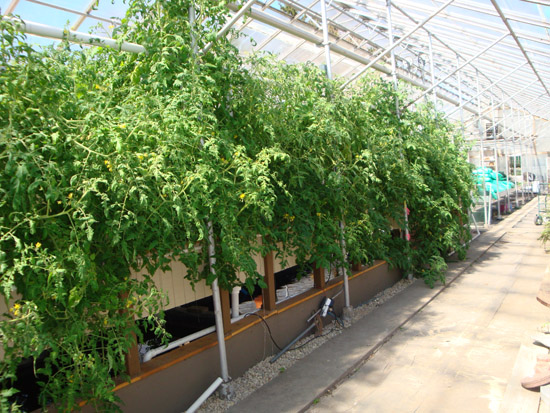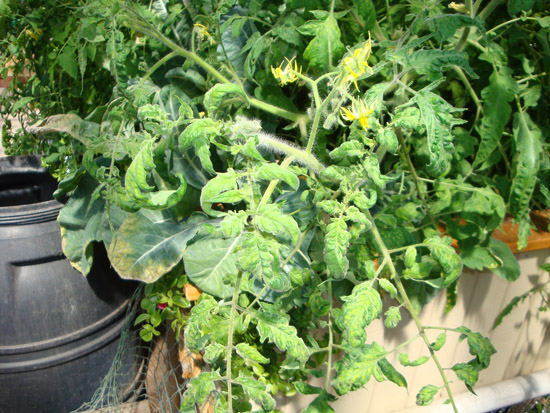Issue 10, June 27, 2011
U of I PLANT CLINIC: PLANT (CSI)

Plant Crime Scene
Unfortunately, we are not able to come to the site where the affected plant is growing, but a lot of times, we receive or request pictures of the "plant scene." Then, if we are unsure of the problem, we recommend that you send the plant sample or "Plant Crime Scene Evidence" to the U of I Plant Clinic lab.

What could be causing this plant to have these symptoms? Chemical? Virus? Nutrient deficiency? Insect? ….or is a combination of several of these factors? Do you know? If not, you may need to send a sample to the U of I Plant Clinic.
Once the plant sample arrives at the U of I Plant Clinic, we do an "initial walk-through" to get an overall feel for the injured or abnormal plant. Luckily, we don't have to worry about touching things or contaminating the plant evidence. Now, this is when we come up with some leads or possible diagnosis, based on visual plant symptoms.
At the Plant Clinic, we don't swab or collect fingerprints, hair, or dried blood. We look for signs of fungal diseases, nematodes, and insects or symptomology of chemical, environmental, or nutrient issues.
We do try to document all of this "evidence." And, of course, we are very, careful to preserve this plant evidence in its current form by using refrigeration or even watering (if we have an entire plant). Sometimes, we even document the "plant crime scene" by taking pictures, sketches, but no video walkthroughs are necessary.
After this, we take the plant sample to the scopes (dissecting scope and microscope) to collect further evidence, which could lead to a potential diagnosis. We don't use a swab, but we do use forceps, as well as other tools such as pruners, knives, or razor blades. Here are some things we may find on the plant sample in question: fungal structures, fungal spores, bacterial oozing, nematodes, or insect exoskeletons, frass, webbing, and feeding. Depending on the plant symptoms, we may choose to culture the sample to isolate a specific bacterial or fungal pathogen. In some cases, we might even use assays or quick strip tests involving ELISA or PCR! Then, I guess you could say we tag, log, and package it!
If we can't find any of these things above (signs of disease, insect, or nematode), that is when it can get tricky! It could be an environmental, nutrient, or a chemical injury situation. In cases such as these, we may need to rely on information included with the sample, phone inquiries, or documents such as soil tests, water analysis, or pesticide application logs.
Don't forget, once we have a plant sample in hand, we reserve the right to contact a grower, and perform a full interrogation! No, we don't ask them where the plant was in the night in question, but we may ask questions such as:
When was it planted?
What pesticides have been applied?
When were the pesticides applied?
Have you had a soil test?
What fertilizer has been applied?
What was the rate of fertilizer applied?
What has the weather been like?
How long have you had this problem?
In what kind of site is this plant growing?
Was it planted correctly?
What is planted in this area before?
What is the soil type?
What is the condition of the nearby plants?
How old is the plant?
What is the pattern of the affected plants?
What is the name of the plant species?
Are you a homeowner or a commercial grower?
Just to name a few.
When all of the evidence is collected and research has been done (books and internet), the plant case goes straight to the lead detective or in our case, the diagnostician (that's me). If I need to, I can also consult with experts on diagnosis and management strategies. Now, I don't deal with experts in blood pattern spatter, trajectory determination, or serology (blood and bodily fluids), but rather deal with campus specialists that can help me in more specific areas such as crop, fruit, and vegetable pathology, fertility, weeds, horticulture, or entomology.
Some Plant CSI's only work in the field - these are Extension Educators, Extension Coordinators, Consultants, and Master Gardeners. They help to collect the evidence and they pass it to our forensic lab - The U of I Plant Clinic!
Based on these procedures, we can hopefully, MAKE A PLANT DIAGNOSIS! (Stephanie Porter)
Author:
Stephanie Porter